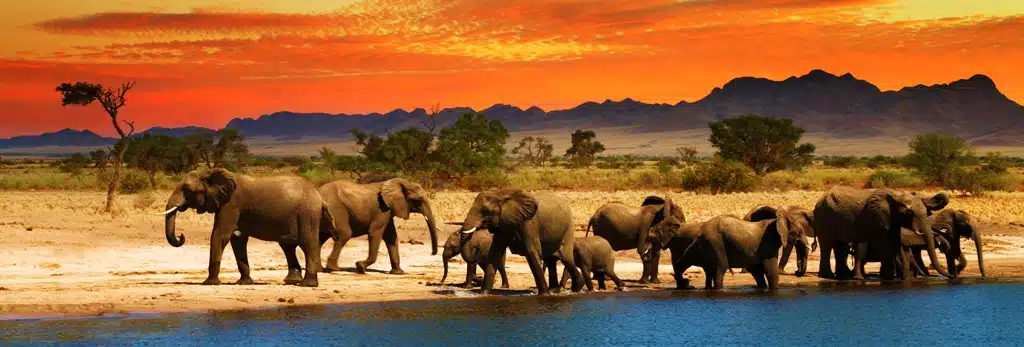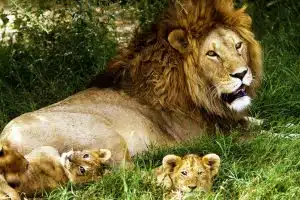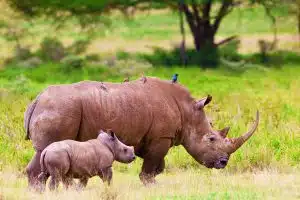Africa: A land Where Wildlife Reigns Supreme
SEE OUR TRIPS TO AFRICA
I just returned home from Africa. I still can’t believe it, I was in Africa! Before going there, I didn’t have anything to relate Africa to except the many National Geographic specials I had watched on television since I was a child. What I saw and experienced there, was more than I had ever imagined!
Imagine endless plains teeming with herds of impalas, giraffes, elephants, rhinos, zebras and many more. Imagine a place completely unaware of civilization, where wildlife still reigns supreme. It’s hard to believe a place like this still exists, but it does. It is called The Kruger National Park in South Africa. It captured my soul!
Kruger National Park is one of the largest game reserves in Africa. It covers over 7,000 square miles, extending 220 miles from north to south and 40 miles from east to west. Zigs zagging through the park are dirt roads where our tour group divided, climbed into open air land rovers and raced across the grassy plains of the African bush. We were in search of, and to photograph the “big five”.
The phrase “big five” was coined by white hunters and refers to the five most difficult animals in Africa to hunt on foot. The term is still used by most tourist and wildlife guides on African safaris. The big five consists of the lion, the African elephant, the Cape buffalo, the leopard and the rhinoceros.
It’s easy to describe a wildlife encounter in the bush – all of one’s senses come alive. It’s a continual adrenalin rush. The crisp morning air rushing against your face, as the vehicle speeds along. A burst of light as the morning sun makes its appearance above the horizon; the best time to glimpse the animals is at sunrise. Then suddenly, ahead is a herd of Elephants lumbering across the dirt road. The land rover stops less than 20 feet away from the herd. These animals are not threatened by our presence. They have seen these vehicles packed with humans before.
With the herd are scores of their babies staying close to the safety of their mothers. As small as they are, our African guide and driver inform us that at birth it is common for an elephant calf to weigh 260 pounds. They typically live for 50 to 70 years. Later that day we would see two male bulls going head to head and tusk to tusk as they challenged one another for the attention of a female elephant.
Our next encounter is with a group of giraffes and a herd of zebras. The giraffes are magnificent, standing as tall as 17 feet and weighing up to 1800 pounds. They stare at us quizzically and then return to their forging of leaves from surrounding trees. Zebras have learned to stay close to the giraffes because of their unobstructed view of their surroundings, while the giraffes benefit from the zebra’s sensitive hearing. Their abilities assist one another against their natural predator, the lion.
As we continue to drive along the dusty road, our guide suddenly applies the brakes bringing our vehicle to a halt. Everyone strains their eyes looking for wild life, but we see nothing. Our guide points to the road below us. There, hustling across the dusty path, we see a Dung Beetle pushing a ball of dung. The beetle is moving about 20 feet a minute. It’s fascinating! Dung Beetles, known as rollers, are noted for gathering dung into spherical balls, which are used as a food source. Dung Beetles can roll up to 50 times their weight pushing the ball forward using their hind legs. This is comparable to a human, with their feet planted firmly against the back of a school bus, pushing it forward using their hands on the road.
All of our vehicles are equipped with short wave radios to alert the groups to a sighting of one of the “big five”. Suddenly our radio comes to life, a leopard has been spotted. Off we roar to the place of the sighting. We arrive in time to see this magnificent predator lazily stroll through the bush.
The Leopard has the ability to run at speeds approaching 40 miles per hour, has a notorious ability for stealth and has an unequaled ability to climb trees even when carrying a heavy carcass. The leopard consumes virtually any animal that it can hunt down and catch.
Throughout our safaris through Kruger National Park and Chobe National Park in Zambia we saw rhinos, hippos and impalas, crocodiles, kudus, wart hogs and many more. Lizzie and I saw four of the “big five”, missing the lion. Some of our group saw them all.
Africa is a place where a deep sense of peace can be felt, where the soul can recharge. It’s a land where one can appreciate God’s magnificent creations in their natural habitat. This is a place completely unaware of civilization It’s a place not to be missed.





